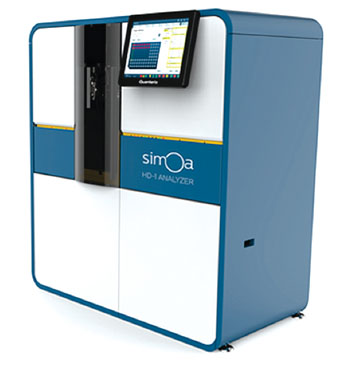Possible Blood Biomarker Found for Traumatic Brain Injury
By LabMedica International staff writers
Posted on 09 Mar 2015
New technology could help advance blood biomarker capabilities for improved diagnosis, treatment and prognosis of traumatic brain injury (TBI). Posted on 09 Mar 2015
The equipment being launched could help scientists develop blood biomarker resources that show changes in low concentrations of specific proteins present following a neurological injury.

Image: The single molecule array (Simoa) technology and the fully automated HD-1 digital immunoassay platform (Photo courtesy of Quanterix).
There have been limits in tissue availability and technology to detect specific proteins and other potential biomarkers in the blood following TBI. Analyzing cerebrospinal fluid (CSF) has been the most common approach to date to measure these proteins. However, this requires an invasive procedure, and it is not always available or obtainable with certain injuries. Nor is it regularly used to monitor progression and recovery because of its invasive nature.
The single molecule array (Simoa) technology developed by Quanterix (Lexington, MA, USA) and their fully automated HD-1 analyzer, offers unprecedented improvement in protein sensitivity over current technologies for the detection of blood-based biomarkers. The new method is as much as 1,000 times more sensitive than conventional immunoassays. Specifically, it allows for more effective measurement of low concentration of proteins, such as tau, a normal protein that is released from brain cells following a brain injury. Scientists utilizing this technology hope to develop and validate a simple, more objective blood biomarker for the diagnosis, prognosis and treatment of traumatic brain injury (TBI).
Mony J. de Leon, EdD, a professor of psychiatry at Langone Medical Center (New York, NY, USA) said, “This diagnostic advancement provides us with a more precise ruler for measuring the effectiveness of diagnosis, treatment and progression of TBI. We know that increased tau proteins in the cerebrospinal fluid are a marker for TBI. Having more immediate and consistent access to tau measurements from the blood or saliva will allow us to more accurately determine if a brain injury has, indeed, occurred, and how well a patient is responding to treatment.”
Charles L. Marmar, MD, the Lucius Littauer professor and chairman of Psychiatry at Langone Medical Center, added, “The Quanterix Simoa will accelerate the discovery of new biomarkers to identify TBI and the development of new treatments, including targeted medications and other therapies. It is truly a breakthrough for advancing detection and treatment of brain injuries.”
Related Links:
Quanterix
Langone Medical Center














